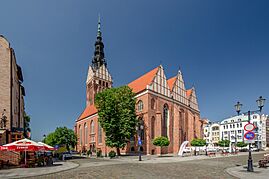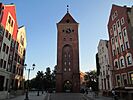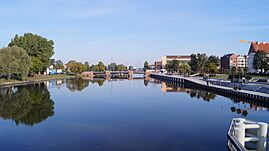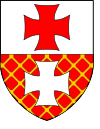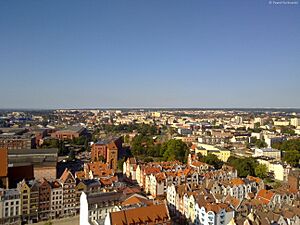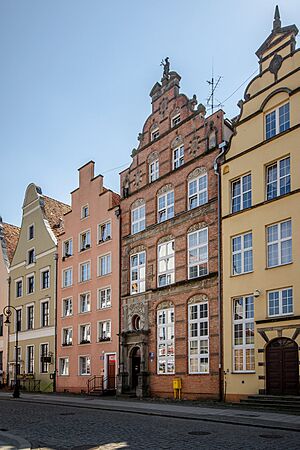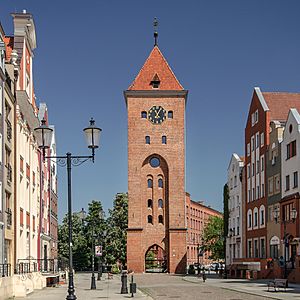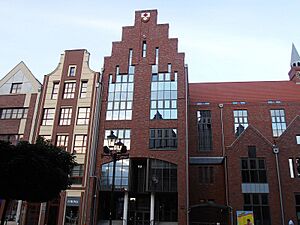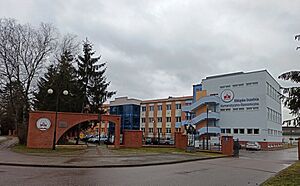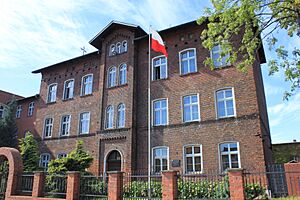Elbląg facts for kids
Quick facts for kids
Elbląg
|
|||
|---|---|---|---|
|
|||
|
|||
| Country | |||
| Voivodeship | |||
| County | City county | ||
| Established | 1237 | ||
| City rights | 10 April 1246 | ||
| Area | |||
| • Total | 7,952 ha (19,650 acre) | ||
| • Water | 102 ha (252 acre) | ||
| • Urban | 1,975 ha (4,880 acre) | ||
| Population
(31 December 2021)
|
|||
| • Total | 127,390 |
||
| • Density | 1,595/km2 (4,130/sq mi) | ||
| Time zone | UTC+1 (CET) | ||
| • Summer (DST) | UTC+2 (CEST) | ||
| Postal code |
82-300 to 82-315
|
||
| Area code(s) | +48 55 | ||
| Geocode | 54.17216,19.41865 | ||
| Car plates | NE | ||
| Climate | Dfb | ||
| Highways | |||
| National roads | |||
Elbląg is a city in northern Poland. It's located in the Warmian-Masurian Voivodeship and has about 127,000 people. It's one of the oldest cities in the region.
Its story began in 1237. That's when the Teutonic Order, a group of knights, built a strong fort by a river. This fort became their main base. Elbląg later joined the Hanseatic League, a powerful trading group. This made the city very rich. It connected Elbląg to big ports like Gdańsk and Amsterdam.
In 1454, Elbląg became part of Poland. After a big war, this was officially recognized in 1466. The city grew into an important trading hub. However, wars in the 17th century slowed its growth.
In 1772, Elbląg became part of Prussia. Its trading power decreased. But in the 1800s, during the Industrial Age, things changed. The famous Elbląg Canal was built. This canal is now a popular tourist spot. It's even called one of the Seven Wonders of Poland!
After World War II, Elbląg returned to Poland. Much of its historic Old Town was destroyed. New Polish settlers moved to the city. Today, Elbląg is a lively city. It's a center for learning and business. You can visit historic places like the Market Gate from 1309. The St. Nicholas Cathedral is also a must-see. Elbląg is also known for its old archaeological sites and museums. It even has the largest brewery in Poland!
Contents
What's in a Name?
The name Elbląg comes from the older German name Elbing. This was the name the Teutonic Knights used for both the river and the fort they built in 1237. They built the fort to stop the Old Prussians, a local pagan group, from returning to their old settlement. The river's name itself is very old. Some think it's linked to an ancient Germanic tribe called the Helveconae. The oldest known mention of the river is from the late 800s. A sailor named Wulfstan called it Ylfing in a report written for King Alfred of England.
Elbląg Today
Elbląg was almost completely destroyed at the end of World War II. Slowly, parts of the inner city were rebuilt. Around the year 2000, people started rebuilding in a style that looked like the old buildings. They even used old bricks and parts of the original walls!
The modern city stretches along the Elbląg River. This river connects Lake Drużno to the Vistula Lagoon. The city is mostly on the eastern side of the river. To the east, you'll find the Elbląg Upland. This is a dome-shaped area of hills, about 200 meters high.
If you look west, you'll see flat fields. This area is part of the Vistula Delta and is used for farming. To the south are the marshes and swamps of Lake Drużno. The Elbląg River flows naturally through the city. But in other places, it's a controlled channel with branches. One branch, the Jagiellonski Channel, leads to the Nogat River. The famous Elbląg Canal connects Lake Drużno with other lakes. It's a great place for tourists to visit.
Elbląg's Port
Elbląg is not a deep-water port. This means very large ships can't use its waterways. Ships must be no deeper than 1.5 meters. Large ships also need a pilot to help them turn. Before 2022, larger ships couldn't reach the open Baltic Sea without going through Russian territory. But now, thanks to the Vistula Spit canal, ships can access the Baltic Sea while staying in Poland! The city has three main quay areas, cranes for loading, and railway connections.
Where is Elbląg?
Elbląg is about 55 kilometers southeast of Gdańsk. It's also about 90 kilometers southwest of Kaliningrad, Russia. The city is a port on the Elbląg River. This river flows into the Vistula Lagoon about 10 kilometers north. This gives Elbląg access to the Baltic Sea. The historic Old Town is located on the river.
A Look at History
![]() Teutonic Order 1246–1454
Teutonic Order 1246–1454
![]() Kingdom of Poland 1454–1569
Kingdom of Poland 1454–1569
![]() Polish–Lithuanian Commonwealth 1569–1772
Polish–Lithuanian Commonwealth 1569–1772
![]() Kingdom of Prussia 1772–1871
Kingdom of Prussia 1772–1871
![]() German Empire 1871–1918
German Empire 1871–1918
![]() Weimar Germany 1918–1933
Weimar Germany 1918–1933
![]() Nazi Germany 1933–1945
Nazi Germany 1933–1945
![]() People's Republic of Poland 1945–1989
People's Republic of Poland 1945–1989
![]() Republic of Poland 1989–present
Republic of Poland 1989–present
Ancient Truso
The area where Elbląg is located has a very long history. An old Viking settlement called Truso was here. It was first mentioned around 890 by a sailor named Wulfstan. Truso was located near Lake Drużno, close to where Elbląg is today. It was a very important seaport. It was part of major trade routes across the Baltic Sea. Traders bought and sold things like amber, furs, and even slaves.
Archaeologists have found many ancient items from Truso. These include burned wooden beams and ashes. Many of these artifacts are now on display at the Muzeum w Elblągu. Truso burned down in the 10th century.
The Teutonic Knights Arrive
In the early 1200s, the Teutonic Knights came to this region. They were a military order that wanted to conquer and convert the local pagan Prussians. In 1237, they built a castle and founded the town of Elbing. Most of the new settlers came from Lübeck.
The Knights used ships to clear the Vistula Lagoon of local resistance. The first fort was built on an island in the Elbing River. Later, it was moved to the current city site. In 1238, the Dominican Order was invited to build a monastery. Elbing's first industry was making amber and bone items for trade.
An old book called the Elbing Vocabulary was found in 1825. It listed 802 words in the Old Prussian language. This book helped people understand the language of the original inhabitants.
In 1246, Elbing was given special rights under "Lübeck law." This law was often used in port cities. It allowed the town to govern itself. Being part of the Hanseatic League meant Elbing had strong trade links with countries like England and France. The city gained many trading benefits from different rulers. For example, in 1393, it got special rights for trading grains and metals.
At first, Elbing was a small village. It had a wharf, a market, and a few streets. The castle was finished in 1251. In 1288, a fire destroyed most of the town. But the brick churches survived. The city was rebuilt from 1315 to 1340. A new part of town, called New Town, was founded around 1337. In 1349, the Black Death (a terrible plague) hit the city. After the population recovered, they continued building. In 1364, a crane was built for the port.
An old German book, the Elbinger Rechtsbuch, recorded Polish common law for the first time. It's the oldest source of documented Polish common law.
In 1410, during a war between Poland and the Teutonic Knights, the people of Elbląg rebelled. They kicked out the Knights and welcomed Polish troops. They swore loyalty to the Polish King, Władysław II Jagiełło. However, the Knights later retook the castle.
Part of Poland
In 1440, Elbląg helped form the Prussian Confederation. This group was against the Teutonic Knights. In 1454, the Confederation asked the Polish King, Casimir IV, to include the region in Poland. The King agreed. This started the Thirteen Years' War, a long war between Poland and the Knights.
The people of Elbląg recognized Casimir IV as their ruler. The city was given great privileges, similar to other big Polish cities. From 1454, Elbląg was allowed to make its own Polish coins. The war ended in 1466 with a Polish victory. The Teutonic Order gave up its claims to Elbląg.
Within Poland, Elbląg was an important city. It had voting rights during the election of Polish kings. The famous scientist Nicolaus Copernicus visited Elbląg often between 1504 and 1530.
In the 1500s, many people in Elbląg became Protestants. The first Lutheran school was set up in 1535. Elbląg had strong trade ties with England. English, Scottish, and Irish merchants settled in the city. By 1618, Elbląg left the Hanseatic League because of its close ties with England.
During the Thirty Years' War, the Vistula Lagoon was a key base for the Swedish King. From 1700 to 1710, Swedish troops occupied Elbląg. In 1710, Russian troops took the city. It was given back to the Polish King in 1712.
Under Prussian Rule
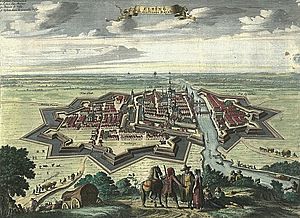
In 1772, during the First Partition of Poland, Elbląg was taken over by Frederick the Great of Prussia. It became part of the new province of West Prussia.
Elbląg became an industrial city. In 1828, the first steamship was built here. In 1837, Ferdinand Schichau started his famous company, Schichau-Werke. This company built ships, engines, and torpedoes. After a railway to Königsberg opened in 1853, Elbląg's industry grew even more. Schichau built large housing complexes for his many workers.
An engineer named Georg Steenke built the Elbląg Canal. This canal connected Elbląg to the southern part of Prussia. It's a truly amazing engineering feat!
In 1871, Elbląg became part of the German Empire. After World War I, most of West Prussia returned to Poland. But Elbląg remained part of Germany.
World War II and After

During World War II, under Nazi Germany, the city had prisons and forced labor camps. Many Polish people were forced to work there. Polish resistance fighters were active in the city.
As the Soviet army approached in 1945, many German residents fled. The city was under siege from January 23, 1945. About 65% of the city was destroyed, especially the historic center. The Soviet army captured the city on February 9/10, 1945.
After the war, in spring 1945, Elbląg became part of Poland again. The remaining German residents moved to Germany. Polish people, many of whom had been forced to leave eastern Polish areas taken by the Soviet Union, settled in Elbląg.
The damaged Old Town was mostly torn down. The bricks were used to rebuild Warsaw and Gdańsk. The plan was to build modern apartment blocks, but this didn't happen. Two churches were rebuilt. The rest of the Old Town ruins were cleared in the 1960s.
Since 1990, the Old Town has been restored. Archaeologists have found many artifacts from the city's past. Some new buildings even include parts of the old stonework. By 2006, about 75% of the Old Town had been rebuilt.
Elbląg is also home to the Elbrewery. This is Poland's largest brewery. Brewing in Elbląg dates back to 1309! The current brewery was founded in 1872. It even supplied beer to the German Emperor in the early 1900s.
Historic Buildings to See
Before World War II, Elbląg's Old Town had many beautiful Gothic, Renaissance, and Baroque houses. Some of them have been rebuilt. Other preserved buildings include:
- St. Nicholas Cathedral - A huge Gothic church from the 13th century. It was damaged in World War II but has been repaired.
- Brama Targowa (Market Gate) - Built in 1319.
- St. Mary's Church - A former Dominican church from the 13th century. It was rebuilt after being damaged in World War II and is now an art gallery.
- Holy Ghost church with hospital - From the 14th century.
- Corpus Christi church - Also from the 14th century.
- Ścieżka kościelna (Church Path) - A medieval path between old buildings that connected the churches.
- Gothic houses at 13 Świętego Ducha Street and 34 Studzienna Street (reconstructed).
- Mannierist houses in the Old Town, like the Jost van Kampen House.
- The modern reconstruction of the Old Town, including the new Old Town City Hall.
- Church of Good Shepherd - An old Mennonite church from 1890.
The Elbląg Canal, built between 1825 and 1844, is a major tourist attraction. It's considered one of the most important engineering monuments in history. It's even one of the Seven Wonders of Poland! In 2011, it was named an official national Historic Monument of Poland.
Culture and Fun
Elbląg has several cultural places:
- The Archaeological and Historical Museum: It shows many art pieces and everyday items. It even has the only 15th-century binoculars left in Europe!
- The Cyprian Norwid Elbląg Library.
- The EL Gallery Art Center.
- The Aleksander Sewruk Theater.
Education
Elbląg has several places for higher education, where students can study different subjects:
- Elbląg Higher School of Arts and Economics
- You can study teaching, administration, health sciences, economics, and politics here.
- Elbląg Higher State College of Vocational Education
- This college offers studies in teaching, foreign languages, economics, computer science, and technical sciences.
- Bogdan Jański Higher School, Faculty in Elbląg
- Here you can study management and land management.
- Elbląg Diocese Theological Seminary
- Regent College - Foreign Language Teacher Training College
- This college focuses on English Studies.
Sports
| Club | Sport | League | Trophies |
|---|---|---|---|
| Start Elbląg | Women's handball | Superliga | 2 Polish Championships (1992, 1994) 3 Polish Cups (1993, 1994, 1999) |
| Olimpia Elbląg | Men's football | II liga | 0 |
City Friends Around the World
Elbląg has "twin town" or "sister city" relationships with other cities around the world. This helps them share culture and ideas.
|
|
Elbląg used to be twinned with Kaliningrad and Baltiysk in Russia, and Novogrudok in Belarus. However, these partnerships ended in 2022. This was in response to the 2022 Russian invasion of Ukraine.
Images for kids
See also
 In Spanish: Elbląg para niños
In Spanish: Elbląg para niños


